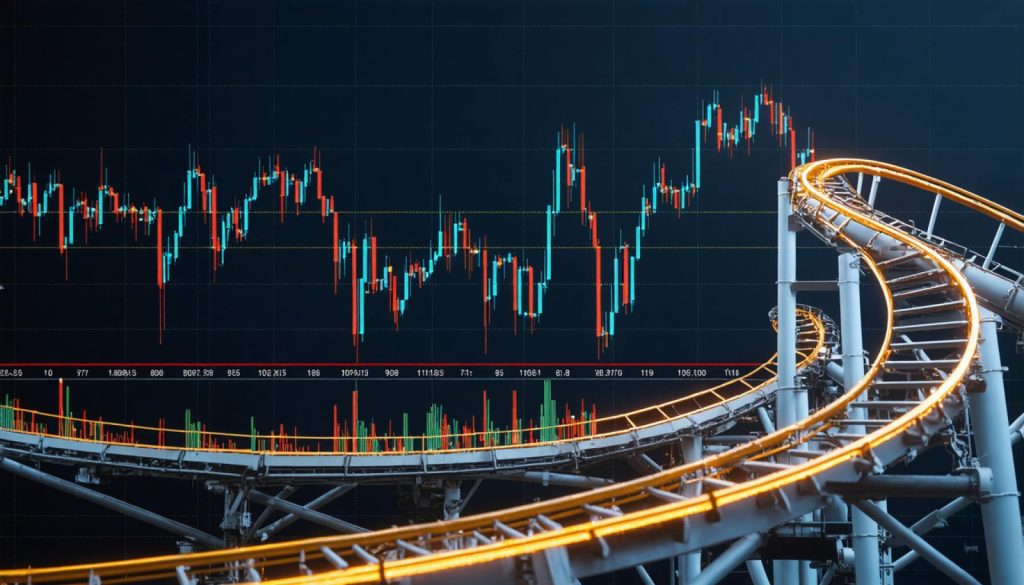- The Dow Jones Industrial Average suffered significant losses, with a 4% drop on Thursday and a 5.5% fall on Friday, marking its 54th and 24th largest declines since 1950.
- The S&P 500 experienced a nearly 6% drop on Friday, echoing downturns seen during the 2008 Great Recession.
- The Nasdaq Composite fell almost 6% on Thursday and 5.82% on Friday, marking two of its largest 30 single-day declines.
- Market turmoil was triggered by a new tariff announcement from President Donald Trump, heightening fears of reduced global trade.
- The events are reminiscent of past financial crises, emphasizing the importance of historical awareness and investor vigilance.
As the sun set on Wall Street this past Friday, traders were left dazed in the wake of two formidable drops in major U.S. stock markets. A ripple set off by a sweeping tariff announcement had careened into a tidal wave of economic uncertainty, reminiscent of the market collapses that haunted investors in the past.
The Dow Jones Industrial Average, standing as a stalwart barometer of economic sentiment since 1896, took a nosedive not seen since the grueling days of June 2020. Thursday heralded an abrupt 4% plunge, only to be outdone by Friday’s staggering 5.5% drop, thrusting these dates into the annals of its 54th and 24th largest collapses since 1950. It was a stark reminder of the ghosts of past financial catastrophes like Black Monday in 1987 when the Dow was devastated by a 22% loss that sent shockwaves globally.
The S&P 500, the heartbeat of 500 leading companies in America, mirrored this turmoil. Friday’s disheartening closure saw nearly a 6% drop, marking its 19th most significant single-day decline. It’s hard not to draw parallels to the tumultuous days of 2008’s Great Recession, where the index once again found itself reeling from similarly sharp downturns.
Meanwhile, the youthful Nasdaq Composite, with its impressive array of technology stocks, exhibited its own brand of vulnerability. It bore witness to a nearly 6% descent on Thursday, followed by a slightly milder yet still jarring 5.82% drop on Friday. These figures etched these days into the upper echelons of its largest 30 single-day percentage declines.
Behind this market turmoil stood President Donald Trump’s announcement, a barrage of tariffs poised to hit imports from across the globe harder than ever before. The policy’s potential to stifle trade had cast a long shadow over market optimism, rekindling fears long thought dormant since the early pandemic-driven sell-offs.
The takeaway? In the ever-volatile theater of global finance, the past often serves as both teacher and harbinger. Investors, while scrambling to adapt to immediate shocks, must remember that history can repeat itself, each turn of the cycle bringing with a sobering reminder to remain vigilant. These harrowing drops serve not just as data points on a graph but as vivid stories in the larger, ongoing narrative of global economics.
Shocking Stock Market Drop: What It Means for Your Investments
Introduction
As Wall Street closed on a turbulent Friday, the precipitous declines in major U.S. stock indices reminded investors of historical market collapses. Triggered by a sweeping announcement of new tariffs, these declines underlined the importance of understanding the broader economic context and preparing for potential market volatility. Here, we delve beyond the numbers to explore the far-reaching implications and provide actionable insights for you as an investor.
Details on the Market Decline
The Dow Jones Industrial Average, a critical gauge of U.S. economic health, experienced consecutive sharp drops, marking its 54th and 24th largest collapses since 1950. These declines bring back memories of Black Monday in 1987 and the financial crisis of 2008, where similar dynamics rocked global markets.
The S&P 500, representing 500 leading companies, similarly felt the pressure with a nearly 6% drop. Such declines are reminiscent of the tumultuous eras of economic downturn, like the Great Recession, where financial stability seemed elusive.
The Nasdaq Composite, known for its concentration of technology stocks, wasn’t spared. It endured a near 6% drop on Thursday, followed by a similar decline Friday, marking them among its largest single-day percentage downfalls.
Additional Market Context and Analysis
Tariff Impact and Economic Implications
The tariff announcement by President Donald Trump promises to weigh heavily on global trade. By increasing costs on imports, the tariffs could lead to heightened consumer prices, strained international relations, and reduced corporate earnings—particularly for businesses reliant on global supply chains.
Comparing Past and Present
The current market volatility isn’t unprecedented. Past incidents, such as Black Monday and the 2008 financial crisis, also involved complex interplays of policy decisions and global economic conditions. Historically, markets have shown resilience, eventually recovering and often reaching new heights.
Industry Trends and Forecasts
1. Technology Sector Resilience: Despite declines, technology stocks often bounce back quicker than other sectors. Advancements in AI and cloud computing continue to drive long-term growth ([source](https://www.morganstanley.com)).
2. Healthcare Investment: With an aging global population, healthcare remains a steady investment choice, with innovation and drug developments offering growth potential ([source](https://www.goldmansachs.com)).
3. Sustainability Initiatives: Green technology and sustainable energy sectors show promise as countries pivot towards renewable energy sources amid climate change concerns ([source](https://www.bcg.com)).
Actionable Recommendations
1. Diversification: Spread investments across various asset classes and sectors to mitigate risk. A balanced portfolio can weather market drops more effectively.
2. Long-Term Perspective: Focus on long-term growth rather than short-term market fluctuations. Historical data suggests that patience and strategic investments yield favorable results over time.
3. Evaluate Risk Tolerance: Regularly assess your risk appetite and adjust your investment strategy accordingly. Younger investors might take more risks than those nearing retirement.
4. Consult with Financial Advisors: Professional advice can help tailor strategies to your specific needs and navigate turbulent market conditions.
Conclusion
In light of recent market disruptions, it is crucial for investors to remain informed and adaptive. Recognizing patterns from past market movements and understanding current economic policies can guide sound investment decisions. Embrace diversity in your portfolio, maintain a long-term outlook, and seek professional advice as needed.
For more insights on investment strategies and market trends, visit Bloomberg and Financial Times for comprehensive financial coverage.










